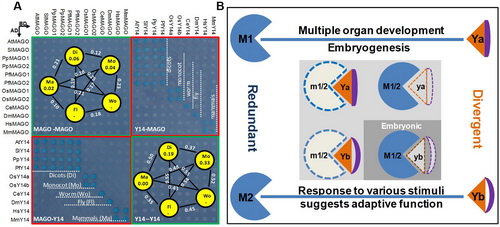植物所揭示MAGO和Y14蛋白家族协同进化机制及生物学意义

MAGO和Y14蛋白家族的协同进化和它们在水稻中的功能分化样式
(A)两蛋白家族的协同进化在维持MAGO-Y14异源二聚体形成中起重要作用。(B)水稻MAGO和Y14旁系同源基因对间的功能分化样式。
蛋白家族间的协同进化是一个重要的进化现象,其机制尚不清楚。外显子拼接复合体(EJC)的核心成员MAGO和Y14属不同蛋白家族,它们在同一物种中形成专性异源二聚体。
中科院植物研究所贺超英研究组近期研究表明,MAGO和Y14起源于真核生物,专性异源二聚体MAGO-Y14的形成为近祖征,协同进化过程在两个基因家族功能和专性异源二聚体的维持中起重要作用。水稻中两个基因均发生了复制,MAGO两同源基因序列高度保守,表达模式相似,功能冗余;Y14两同源基因则在序列和表达模式上发生了显著的分化,单基因敲除引起不同的表型变化。
基因沉默研究表明,MAGO与Y14很可能是以其编码蛋白二聚体的模式影响水稻的生长发育和雄性育性。进一步研究发现,这些水稻EJC成员可结合调控雄蕊发育重要基因OsUDT1的前体RNA,调控其拼接。
该项工作利用多种分析与实验手段阐明了MAGO和Y14蛋白家族协同进化机制及生物学意义,揭示了EJC在水稻生长发育、生殖功能中的作用和潜在的适应性意义,有助于理解被子植物EJC的功能进化和重复基因功能分化机制。
研究结果发表在Plant Physiology(doi: 10.1104/pp.114.237958)和PLoS ONE(9: e84842)上,研究组博士研究生公丕昌是这两篇研究论文的第一作者,赵嫚是后一文章的共同第一作者。
研究得到了国家自然科学基金委、转基因专项和中科院“百人计划”等项目的资助。
原文摘要:
Pichang Gong and Chaoying He
The exon junction complex (EJC) plays important developmental roles in animals; however, its role in plants is not well known. Here, we show various aspects of divergence of each duplicated MAGO- and Y14-gene pair in rice encoding the putative EJC core subunits that form the obligate MAGO-Y14 heterodimers. OsMAGO1, OsMAGO2 and OsY14a were constitutively expressed in all tissues while OsY14b was predominantly expressed in embryonic tissues. OsMAGO2 and OsY14b were more sensitive to different stresses than OsMAGO1 and OsY14a, and their encoded protein pair shared 93.8% and 46.9% sequence identity, respectively. Single MAGO downregulation in rice did not lead to any phenotypic variation; however, double-gene knockdowns generated short rice plants with abnormal flowers, and the stamens of these flowers showed inhibited degradation and absorption of both endothecium and tapetum, suggesting that OsMAGO1 and OsMAGO2 were functionally redundant. OsY14a knockdowns phenocopied OsMAGO1OsMAGO2 mutants while downregulation of OsY14b failed to induce plantlets, suggesting the functional specialization of OsY14b in embryogenesis. OsMAGO1OsMAGO2OsY14a triple downregulation enhanced the phenotypes of OsMAGO1OsMAGO2 and OsY14a downregulated mutants, indicating that they exert developmental roles in the MAGO-Y14 heterodimerization mode. Modified gene expression was noted in the altered developmental pathways in these knockdowns, and the transcript splicing of OsUDT1, a key regulator in stamen development was uniquely abnormal. Concomitantly, MAGO and Y14 selectively bound to the OsUDT1 pre-mRNA, suggesting that rice EJC subunits regulate splicing. Our work provides novel insights into the function of the EJC locus in growth, development and reproduction in angiosperms, and suggests a role for these genes in the adaptive evolution of cereals.
Pichang Gong, Man Zhao, Chaoying He
The exon junction complex (EJC) plays important roles in RNA metabolisms and the development of eukaryotic organisms. MAGO (short form of MAGO NASHI) and Y14 (also Tsunagi or RBM8) are the EJC core components. Their biological roles have been well investigated in various species, but the evolutionary patterns of the two gene families and their protein-protein interactions are poorly known. Genome-wide survey suggested that the MAGOand Y14 two gene families originated in eukaryotic organisms with the maintenance of a low copy. We found that the two protein families evolved slowly; however, the MAGO family under stringent purifying selection evolved more slowly than the Y14 family that was under relative relaxed purifying selection. MAGO and Y14 were obliged to form heterodimer in a eukaryotic organism, and this obligate mode was plesiomorphic. Lack of binding of MAGO to Y14 as functional barrier was observed only among distantly species, suggesting that a slow co-evolution of the two protein families. Inter-protein co-evolutionary signal was further quantified in analyses of the Tol-MirroTree and co-evolution analysis using protein sequences. About 20% of the 41 significantly correlated mutation groups (involving 97 residues) predicted between the two families was clade-specific. Moreover, around half of the predicted co-evolved groups and nearly all clade-specific residues fell into the minimal interaction domains of the two protein families. The mutagenesis effects of the clade-specific residues strengthened that the co-evolution is required for obligate MAGO-Y14 heterodimerization mode. In turn, the obliged heterodimerization in an organism serves as a strong functional constraint for the co-evolution of the MAGO and Y14 families. Such a co-evolution allows maintaining the interaction between the proteins through large evolutionary time scales. Our work shed a light on functional evolution of the EJC genes in eukaryotes, and facilitates to understand the co-evolutionary processes among protein families.
作者:植物所

